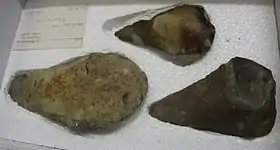Swanscombe Heritage Park
Swanscombe Skull Site or Swanscombe Heritage Park is a 3.9 hectares (9.6 acres) geological Site of Special Scientific Interest in Swanscombe in north-west Kent, England.[1][2] It contains two Geological Conservation Review sites[3][4] and a National Nature Reserve.[5] The park lies in a former gravel quarry, Barnfield Pit.[6]


| Site of Special Scientific Interest | |
 Monument marking the place where the first part of the skull was discovered in 1935 | |
| Area of Search | Kent |
|---|---|
| Grid reference | TQ 597 742[1] |
| Interest | Geological |
| Area | 3.9 hectares (9.6 acres)[1] |
| Notification | 1988[1] |
| Location map | Magic Map |
The area was already known for the finds of numerous Palaeolithic-era handaxes—mostly Acheulean and Clactonian artifacts, some as much as 400,000 years old—when in 1935/1936 work at Barnfield Pit uncovered two fossilised skull fragments. These fragments came to be known as the remains of Swanscombe Man but were later found to have belonged to a young woman.[7] The Swanscombe skull has been identified as early Neanderthal[8] or pre-Neanderthal,[9] dating to the Hoxnian Interglacial around 400,000 years ago.[6]
The skull fragments were found in the lower middle terrace gravels at a depth of almost 8 metres beneath the surface. They were found by Alvan T. Marston, an amateur archaeologist who visited the pit between quarrying operations to search for flint tools. A third fragment from the same skull was found in 1955 by Bertram and John Wymer. Swanscombe is one of only two sites in Britain which have yielded Lower Paleolithic human fossils, the other being Boxgrove Quarry, West Sussex, where 500,000-year-old leg bones and teeth ("Boxgrove Man"), were found.
Further excavations, carried out between 1968 and 1972 by Dr. John d'Arcy Waechter, uncovered more animal bone and flint tools, and established the extent of a former shoreline that the bones were found on.
Most of the bone finds are now in the Natural History Museum in London, with the stone finds at the British Museum. The other key paleolithic sites in the UK are Happisburgh, Pakefield, Pontnewydd, Kents Cavern, Paviland, and Gough's Cave.
See also
References
- "Designated Sites View: Swanscombe Skull Site". Sites of Special Scientific Interest. Natural England. Retrieved 15 January 2018.
- "Map of Swanscombe Skull Site". Sites of Special Scientific Interest. Natural England. Archived from the original on 2016-03-04. Retrieved 15 January 2018.
- "Swanscombe - Barnfield Pit (Quaternary of the Thames)". Geological Conservation Review. Joint Nature Conservation Committee. Archived from the original on 12 January 2018. Retrieved 12 January 2018.
- "Barnfield Pit (Pleistocene Vertebrata)". Geological Conservation Review. Joint Nature Conservation Committee. Archived from the original on 2018-01-15. Retrieved 15 January 2018.
- "Designated Sites View: Swanscombe Skull Site". National Nature Reserves. Natural England. Archived from the original on 2018-05-24. Retrieved 14 January 2018.
- "Swanscombe Skull Site citation" (PDF). Sites of Special Scientific Interest. Natural England. Archived (PDF) from the original on 2018-01-02. Retrieved 15 January 2018.
- Francis Wenban-Smith, Interpretation Archived 2013-07-26 at the Wayback Machine. Retrieved 6 May 2008
- Hendry, Lisa (15 December 2017). "First Britons". Natural History Museum. Archived from the original on 4 August 2018. Retrieved 17 April 2019.
- Ashton, Nick (2017). Early Humans. London, UK: William Collins. p. 147. ISBN 978-0-00-815035-8.